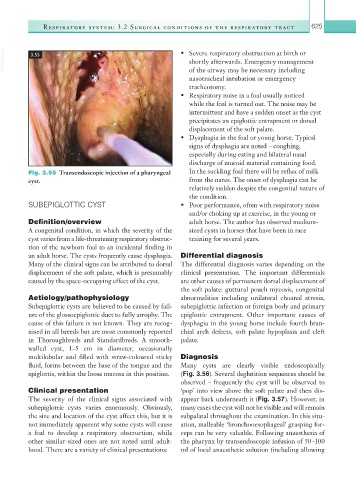Page 650 - Equine Clinical Medicine, Surgery and Reproduction, 2nd Edition
P. 650
Respir atory system: 3.2 Surgical conditions of the respir atory tr act 625
VetBooks.ir 3.55 • Severe respiratory obstruction at birth or
shortly afterwards. Emergency management
of the airway may be necessary including
nasotracheal intubation or emergency
tracheotomy.
• Respiratory noise in a foal usually noticed
while the foal is turned out. The noise may be
intermittent and have a sudden onset as the cyst
precipitates an epiglottic entrapment or dorsal
displacement of the soft palate.
• Dysphagia in the foal or young horse. Typical
signs of dysphagia are noted – coughing,
especially during eating and bilateral nasal
discharge of mucoid material containing food.
Fig. 3.55 Transendoscopic injection of a pharyngeal In the suckling foal there will be reflux of milk
cyst. from the nares. The onset of dysphagia can be
relatively sudden despite the congenital nature of
the condition.
SUBEPIGLOTTIC CYST • Poor performance, often with respiratory noise
and/or choking up at exercise, in the young or
Definition/overview adult horse. The author has observed medium-
A congenital condition, in which the severity of the sized cysts in horses that have been in race
cyst varies from a life-threatening respiratory obstruc- training for several years.
tion of the newborn foal to an incidental finding in
an adult horse. The cysts frequently cause dysphagia. Differential diagnosis
Many of the clinical signs can be attributed to dorsal The differential diagnosis varies depending on the
displacement of the soft palate, which is presumably clinical presentation. The important differentials
caused by the space-occupying effect of the cyst. are other causes of permanent dorsal displacement of
the soft palate: guttural pouch mycosis, congenital
Aetiology/pathophysiology abnormalities including unilateral choanal atresia,
Subepiglottic cysts are believed to be caused by fail- subepiglottic infection or foreign body and primary
ure of the glossoepiglottic duct to fully atrophy. The epiglottic entrapment. Other important causes of
cause of this failure is not known. They are recog- dysphagia in the young horse include fourth bran-
nised in all breeds but are most commonly reported chial arch defects, soft palate hypoplasia and cleft
in Thoroughbreds and Standardbreds. A smooth- palate.
walled cyst, 1–5 cm in diameter, occasionally
multilobular and filled with straw-coloured sticky Diagnosis
fluid, forms between the base of the tongue and the Many cysts are clearly visible endoscopically
epiglottis, within the loose mucosa in this position. (Fig. 3.56). Several deglutition sequences should be
observed – frequently the cyst will be observed to
Clinical presentation ‘pop’ into view above the soft palate and then dis-
The severity of the clinical signs associated with appear back underneath it (Fig. 3.57). However, in
subepiglottic cysts varies enormously. Obviously, many cases the cyst will not be visible and will remain
the size and location of the cyst affect this, but it is subpalatal throughout the examination. In this situ-
not immediately apparent why some cysts will cause ation, malleable ‘bronchooesophageal’ grasping for-
a foal to develop a respiratory obstruction, while ceps can be very valuable. Following anaesthesia of
other similar-sized ones are not noted until adult- the pharynx by transendoscopic infusion of 50–100
hood. There are a variety of clinical presentations: ml of local anaesthetic solution (including allowing

